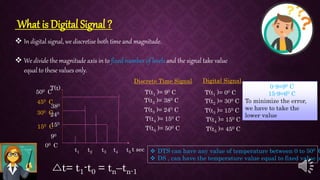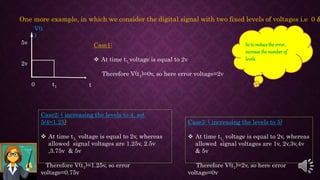Digital signal
- 1. DIGITAL ELECTRONICS Staff Incharge Ms.P.Sivalakshmi .M.E., Assistant Professor/ECE R.M.K College of Engineering & Technology DEPARTMENT OF ELECTRONICS AND COMMUNICATION ENGINEERING
- 2. What is Digital Signal ? ïķ In digital signal, we discretise both time and magnitude. ïķ We divide the magnitude axis in to fixed number of levels and the signal take value equal to these values only. T(t) t1 t2 t3 t4 t5 t= t1-t0 = tnâtn-1 500 C 00 C 380 240 150 90 T(t1 )= 90 C T(t2 )= 380 C T(t3 )= 240 C T(t4 )= 150 C T(t5 )= 500 C Discrete Time Signal Digital Signal T(t1 )= 00 C T(t2 )= 300 C T(t3 )= 150 C T(t4 )= 150 C T(t5 )= 450 C 300 C 150 C 450 C t sec 0-9=90 C 15-9=60 C To minimize the error, we have to take the lower value ïķ DTS can have any value of temperature between 0 to 500 C ïķ DS , can have the temperature value equal to fixed value on
- 3. V(t ) tt10 5v 2v One more example, in which we consider the digital signal with two fixed levels of voltages i.e 0 & Case1: ïķ At time t1,voltage is equal to 2v Therefore V(t1)=0v, so here error voltage=2v Case2: ( increasing the levels to 4, so( 5/4=1.25) ïķ At time t1, voltage is equal to 2v, whereas allowed signal voltages are 1.25v, 2.5v ,3.75v & 5v Therefore V(t1)=1.25v, so error voltage=0.75v Case3: ( increasing the levels to 5) ïķ At time t1, voltage is equal to 2v, whereas allowed signal voltages are 1v, 2v,3v,4v & 5v Therefore V(t1)=2v, so here error voltage=0v So to reduce the error, increase thenumberof levels
- 4. Thank You



